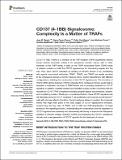Por favor, use este identificador para citar o enlazar a este item:
http://hdl.handle.net/10261/188072COMPARTIR / EXPORTAR:
 SHARE SHARE
 CORE
BASE CORE
BASE
|
|
| Visualizar otros formatos: MARC | Dublin Core | RDF | ORE | MODS | METS | DIDL | DATACITE | |

| Título: | CD137 (4-1BB) Signalosome: Complexity Is a Matter of TRAFs |
Autor: | Zapata, Juan M. CSIC ORCID ; Pérez-Chacón, Gema CSIC ORCID; Carr-Baena, Pablo CSIC; Martinez-Forero, Ivan; Azpilikueta, Arantza; Otano, Itziar; Melero, Ignacio | Palabras clave: | CD137 4-1BB TNFR TRAF1 TRAF2 TRAF3 Immunotherapy Cytotoxic T lymphocytes (CTL) |
Fecha de publicación: | 2018 | Editor: | Frontiers Media | Citación: | Frontiers in Immunology 9: 2618 (2018) | Resumen: | CD137 (4-1BB, Tnsfr9) is a member of the TNF-receptor (TNFR) superfamily without known intrinsic enzymatic activity in its cytoplasmic domain. Hence, akin to other members of the TNFR family, it relies on the TNFR-Associated-Factor (TRAF) family of adaptor proteins to build the CD137 signalosome for transducing signals into the cell. Thus, upon CD137 activation by binding of CD137L trimers or by crosslinking with agonist monoclonal antibodies, TRAF1, TRAF2, and TRAF3 are readily recruited to the cytoplasmic domain of CD137, likely as homo- and/or heterotrimers with different configurations, initiating the construction of the CD137 signalosome. The formation of TRAF2-RING dimers between TRAF2 molecules from contiguous trimers would help to establish a multimeric structure of TRAF-trimers that is probably essential for CD137 signaling. In addition, available studies have identified a large number of proteins that are recruited to CD137:TRAF complexes including ubiquitin ligases and proteases, kinases, and modulatory proteins. Working in a coordinated fashion, these CD137-signalosomes will ultimately promote CD137-mediated T cell proliferation and survival and will endow T cells with stronger effector functions. Current evidence allows to envision the molecular events that might take place in the early stages of CD137-signalosome formation, underscoring the key roles of TRAFs and of K63 and K48-ubiquitination of target proteins in the signaling process. Understanding the composition and fine regulation of CD137-signalosomes assembly and disassembly will be key to improve the therapeutic activities of chimeric antigen receptors (CARs) encompassing the CD137 cytoplasmic domain and a new generation of CD137 agonists for the treatment of cancer. | Versión del editor: | https://doi.org/10.3389/fimmu.2018.02618 | URI: | http://hdl.handle.net/10261/188072 | DOI: | 10.3389/fimmu.2018.02618 | E-ISSN: | 1664-3224 |
| Aparece en las colecciones: | (IIBM) Artículos |
Ficheros en este ítem:
| Fichero | Descripción | Tamaño | Formato | |
|---|---|---|---|---|
| cdtraf.pdf | 2,43 MB | Adobe PDF |  Visualizar/Abrir |
CORE Recommender
PubMed Central
Citations
55
checked on 17-abr-2024
SCOPUSTM
Citations
75
checked on 15-abr-2024
WEB OF SCIENCETM
Citations
72
checked on 23-feb-2024
Page view(s)
234
checked on 19-abr-2024
Download(s)
147
checked on 19-abr-2024

